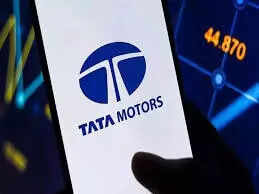
Tata Motors shares fell 3per cent to the day’s low of ₹686 on BSE on Wednesday after the company reported a 51per cent year-on-year (YoY) decline in consolidated net profit to ₹8,470 crore for Q4FY25. Revenue remained flat at ₹1.19 lakh crore. However, the company outperformed Street expectations, with profit exceeding the ET Now poll estimate of ₹7,669 crore.
EBITDA for the quarter fell 4per cent YoY to ₹16,700 crore, with margins narrowing 60 basis points to 14per cent . Both figures were above estimates of ₹16,331 crore and 13.3per cent , respectively.
On a consolidated basis, the company said the automotive business is now debt-free, reducing interest costs. “This is both pleasing and significant as it reflects healthy business fundamentals delivered by a resilient team,” said PB Balaji, Group CFO, Tata Motors.
Jaguar Land Rover
Revenue for the quarter was £7.7 billion, down 1.7per cent YoY, while full year revenue at £29 billion was flat YoY. PBT in Q4FY25 was £875 million, up from £661 million in Q4 FY24. The increase in profitability reflects higher volumes and a reduction in depreciation and amortisation (D&A), partially offset by an increase in VME.
EBIT margin for the quarter expanded 150 bps YoY to 10.7per cent .
Wholesales for Defender hit a new record in FY25 at 115,404 units, Range Rover Sport wholesales for the year were up 20per cent YoY.
“JLR has ended the year with strong annual and quarterly earnings, including delivering our tenth consecutive profitable quarter and our net debt zero target. We have achieved record sales of Defender and are preparing to launch the wonderful Range Rover Electric,” said Adrian Mardell, JLR CEO.
JLR said it implemented a series of short-term actions to address the immediate impact of trade tariffs introduced by the US on the global automotive sector.
The US-UK trade deal, it said, reduces US trade tariffs on UK auto exports to the US from 27.5per cent to 10per cent , within a quota of 100,000 vehicles.
Looking ahead, JLR expects investment spend to remain at £18 billion over a five year period and will be funded by operational cash flows.
Commercial Vehicles
In Q4FY25, domestic wholesale CV volumes were 99,600 units, lower by 5per cent YoY. Exports were at 5,900 units, increasing 29.4per cent YoY.
Revenues for the segment were marginally down by 0.5per cent YoY to ₹21,500 crore cr on account of lower volumes. EBITDA and EBIT margins of 12.2per cent (up 20 bps YoY) and 9.7per cent (up 10 bps YoY), respectively were driven primarily by improvement in realizations.
For the full year, while overall revenues declined by 4.7per cent , EBITDA was up at 11.8per cent as mix and realisations are optimized. The business delivered highest ever profits of ₹6,600 crore during the year.
“Going forward, we remain committed to driving sustainable and profitable growth while improving Vahan market share across all business segments,” said Girish Wagh, Executive Director, Tata Motors.
Passenger Vehicles
PV segment volumes in the quarter were at 147,000 units, which is a decline of 5per cent YoY. Revenues in Q4 also declined 13per cent YoY to ₹12,500 crore. EBIT margin for the segment contracted 130 bps to 1.6per cent , impacted by lower volumes and realizations, partially offset by cost savings and incentives.
In Q4, PV (ICE) business delivered EBITDA margins of 8.2per cent and EV business was EBITDA positive at 6.5per cent . On full year basis, the PV business revenue declined by 7.5per cent . The decline in revenues was primarily on account of decline in hatches volumes.
FY25 EBITDA margins improved by 40 bps, whereas EBIT margins declined by 110 bps due to adverse operating leverage and increase in depreciation and amortization.
“In a year marked by fluctuating demand, Tata Motors Passenger Vehicles led the industry in SUV growth and outpaced the market in CNG sales. Our multi-powertrain strategy and strong commitment to sustainable mobility enabled us to increase the share of CNG and electric vehicles to 36per cent of our overall portfolio,” said Shailesh Chandra, MD, Tata Motors Passenger Vehicles.
Going forward, the company said industry momentum is expected to be driven by continued innovation in line with evolving customer preferences. “SUVs, CNG, and EVs will remain key growth drivers, fueling the industry’s expansion.”
Overall, free cash flow (automotive) for the year stood at ₹22,400 crore as compared to ₹26,900 crore in FY24, owing to cash profits and favourable working capital.

